Ba–Shu culture
Ba–Shu culture (Chinese: 巴蜀文化; pinyin: Bāshǔ wénhuà; Wade–Giles: Pa-Shu wên-hua), sometimes also named Chongqing–Sichuan culture, refers to the culture of Sichuan province and Chongqing city, China and the surrounding areas, including parts of the neighboring provinces of Yunnan and Guizhou, since the Han Chinese subgroups in these two provinces also primarily speak Southwestern Mandarin nowadays. It has a long history of over 3000 years, claimed to be one of the cradles of modern Chinese civilization.[1][2][3]

Pattern of the Golden Sun Bird discovered at Jinsha site, believed to be a totem of the ancient Shu people.
Ancient writing system
Traditional language
Visual arts
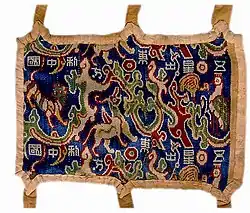
"Five stars rising in the East" armband, a 3rd-century Sichuan brocade armband.

A bronze altar unearthed at Sanxingdui, dating back to the ancient kingdom of Shu
Performing arts
Clothing
Food culture
Others
- Religious sites in Sichuan
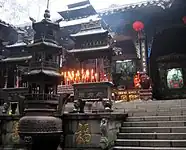
 Golden Temple of Mount Emei of the Chinese Buddhist tradition.
Golden Temple of Mount Emei of the Chinese Buddhist tradition.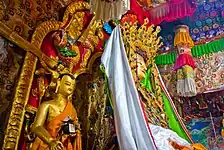 Statues of buddhas at a Litang monastery of the Tibetan Buddhist tradition.
Statues of buddhas at a Litang monastery of the Tibetan Buddhist tradition.![Baba Mosque [zh], a Sichuanese Sufi mosque in Langzhong.](../I/%E5%B7%B4%E5%B7%B4%E5%AF%BA.JPG.webp)
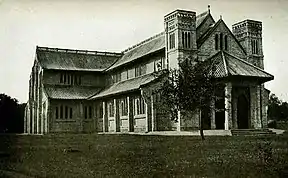
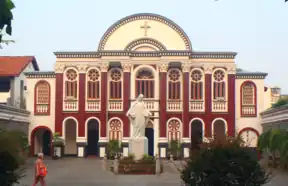
 St. Joseph's Cathedral, Chongqing (Roman Catholic).
St. Joseph's Cathedral, Chongqing (Roman Catholic).
References
- 巴蜀文化渊源. huaxia.com. June 2006. Archived from the original on May 2, 2019. Retrieved September 7, 2017.
- 巴蜀文化. hk.chiculture.net.
- 四川师范大学巴蜀文化中心. Center for Bashu Cultural Studies, Sichuan Normal University.
This article is issued from Wikipedia. The text is licensed under Creative Commons - Attribution - Sharealike. Additional terms may apply for the media files.



